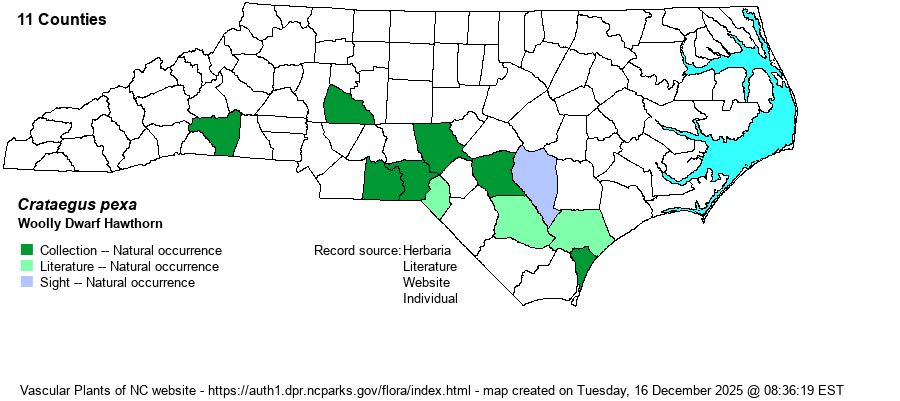| Author | Beadle | |
| Distribution | Occurs mainly in the southern half of the Coastal Plain and in the southern Piedmont, west and north to Rutherford and Rowan counties. As there is a disjunct record in southeast VA, it could well occur in the northern NC Coastal Plain. Its center of occurrence/abundance seems to be in the Cumberland and Bladen counties area (Lance 2014). The range map below is obviously very incomplete, owing to confusing taxonomy and recent elevation to full species status.
This taxon is limited mainly to southern NC and SC, sparingly to northeastern VA, and south to FL and AL. It appears to be most widespread in NC.
| |
| Abundance | Fairly common to common in the Cumberland and Bladen counties area, and perhaps infrequent to fairly common elsewhere in the neighboring Sandhills region to the west. Likely rare to uncommon in the southern Piedmont. The NCNHP places the species on its Watch List. | |
| Habitat | This species occurs in sandy pine/scrub oak forests and woodlands, dry or sandy thickets, and in dry clay soils (mainly in the Piedmont) of uplands woods and thickets. It seems to occur in similar habitats as the quite closely related C. munda. |
| Phenology | Blooms from late March to April, and fruits in September and October. | |
| Identification | This is a medium shrub that grows only to about 5-6 feet tall, shorter than most species but taller than the similar C. munda. Its leaves are quite like C. munda, in being cuneate/wedge-shaped and fairly narrow and small, only to about 1.5 inches long. It differs from that species in having quite long thorns, often 1.5 times to nearly twice the length of the leaves; and the fruits are more rounded than the slightly pear-shaped fruit of C. munda. Lance (2014) indicates that one should be able to easily find this species in parts of Bladen and Cumberland counties. | |
| Taxonomic Comments | Though first described in 1902, this was one of many hawthorns dumped into better known species by most references in the 20th Century, in this case under C. flava. Lance (2014) first placed this “species” as a variety of C. munda – as C. munda var. pexa, but Weakley (2018) and other references have not followed suit, and have considered C. pexa as a good species, at least tentatively. The species is not in the NatureServe database and thus has a GNA (= not applicable) global rank.
| |
| Other Common Name(s) | Pexa Hawthorn | |
| State Rank | S3? | |
| Global Rank | G4G5TNR | |
| State Status | W7 | |
| US Status | | |
| USACE-agcp | | |
| USACE-emp | | |

